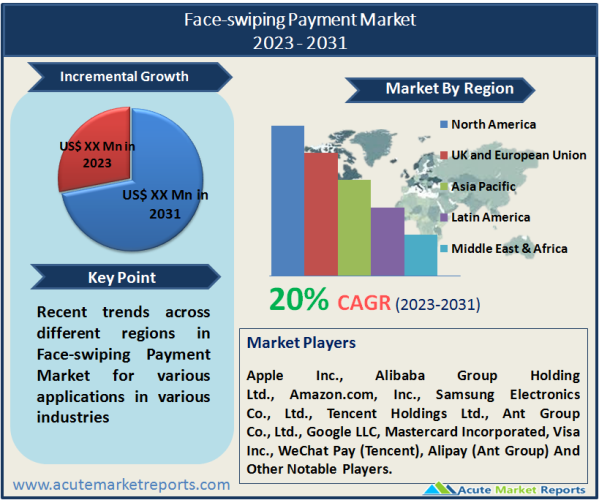
The face-swiping payment market is expected to witness a CAGR of 20% during the forecast period of 2025 to 2033, driven by the increasing adoption of biometric authentication and contactless payment technologies. This innovative payment method allows users to make transactions simply by using facial recognition technology, eliminating the need for physical cards or mobile devices. The market has experienced remarkable revenue growth, with a compound annual growth rate (CAGR) that reflects the growing popularity and acceptance of face-swiping payments among consumers and businesses. The face-swiping payment market has gained traction due to several factors. First and foremost, the convenience and speed offered by this technology have been key drivers of its adoption. With face-swiping payments, users can make transactions swiftly by simply looking at a camera or sensor, eliminating the need to carry physical cards or remember PINs. This seamless and contactless experience aligns with the evolving consumer preferences for frictionless and secure payment methods. Additionally, the heightened focus on security and fraud prevention has propelled the demand for face-swiping payments. Facial recognition technology provides a high level of authentication and security, as it relies on unique facial features and biometric data for identity verification. This enhances the overall security of transactions and reduces the risk of fraudulent activities. Furthermore, the increasing penetration of smartphones and advanced camera technologies has facilitated the widespread adoption of face-swiping payments. With smartphones equipped with front-facing cameras and robust facial recognition capabilities, users can easily utilize this payment method through their mobile devices. This accessibility has expanded the reach of face-swiping payments and made them more accessible to a broader user base.

Convenience and Contactless Experience
The convenience and contactless nature of face-swiping payments have been significant drivers behind their adoption in the market. With this payment method, users can make transactions swiftly and seamlessly by using facial recognition technology, eliminating the need for physical cards or mobile devices. The ease of conducting transactions simply by looking at a camera or sensor provides a frictionless payment experience, enhancing convenience for consumers. This is evidenced by the growing popularity of face-swiping payment services offered by major technology companies such as Apple Pay, Google Pay, and Alipay. These companies have integrated facial recognition technology into their payment systems to enable contactless and convenient transactions, which have gained widespread acceptance among users.
Enhanced Security and Authentication
The emphasis on security and authentication has played a crucial role in driving the adoption of face-swiping payments. Facial recognition technology offers a high level of security by utilizing unique facial features and biometric data for identity verification. This reduces the risk of fraudulent activities and unauthorized access to user accounts. The use of face-swiping payments adds an extra layer of security compared to traditional payment methods that rely on physical cards or PINs, which can be lost, stolen, or compromised. The increasing concern for data privacy and the need for robust security measures have further fueled the demand for face-swiping payment solutions. For instance, smartphone manufacturers like Apple have implemented advanced facial recognition technology (Face ID) in their devices, which not only enables secure unlocking but also facilitates secure face-swiping payments through their mobile payment platforms.
Technological Advancements and Smartphone Penetration
Technological advancements and the widespread penetration of smartphones have significantly contributed to the growth of face-swiping payments. With the increasing availability of smartphones equipped with advanced front-facing cameras and facial recognition capabilities, users have easy access to this payment method. Smartphone manufacturers have invested heavily in developing sophisticated facial recognition technologies that are accurate, fast, and reliable. These advancements have made face-swiping payments more accessible to a broader user base. Furthermore, the growing penetration of smartphones globally has expanded the reach of face-swiping payments, with users from various regions embracing this convenient and secure payment method. The increasing smartphone adoption rates, coupled with the continuous innovation in facial recognition technology, provide a strong driver for the growth of the face-swiping payment market.
Privacy and Data Security Concerns
Privacy and data security concerns represent a significant restraint in the face-swiping payment market. While facial recognition technology offers enhanced security, some users have raised apprehensions regarding the collection, storage, and potential misuse of their biometric data. There have been instances of data breaches and unauthorized access to personal information, which have raised concerns about the vulnerability of facial recognition systems. Additionally, the use of facial recognition technology for payment purposes has raised questions regarding the protection of individuals' privacy and the potential for surveillance. These concerns have led to debates and regulatory scrutiny surrounding the usage of facial recognition technology in various countries. For instance, the European Union's General Data Protection Regulation (GDPR) has imposed stringent guidelines on the collection and processing of biometric data. Users' hesitance to share their facial data and concerns about data security and privacy may restrain the widespread adoption of face-swiping payments unless robust measures are implemented to address these concerns and ensure transparent data handling practices.
Payment Systems Dominated the Market by Type
The face-swiping payment market consists of two main segments: payment equipment and payment systems. While the payment equipment segment focuses on the hardware components required for face-swiping transactions, the payment systems segment encompasses the software and infrastructure for secure transaction processing. The demand for payment equipment is primarily driven by the increasing adoption of facial recognition technology in various industries, such as retail, hospitality, and banking. These devices enable businesses to accept face-swiping payments and provide a seamless payment experience to their customers. The payment equipment segment is expected to witness a CAGR during the forecast period of 2025 to 2033, due to the growing acceptance and integration of face-swiping payment solutions across different sectors. The demand for payment systems is driven by the need for secure and efficient transaction processing, as well as integration with existing payment networks and platforms. This segment generated substantial revenue in 2024, due to the increasing adoption of face-swiping payment solutions by both businesses and consumers.
Retail Segment Dominating the Market by Application
The face-swiping payment market encompasses various application segments, including retail, restaurant, travel, and others. The retail segment held the largest revenue contribution in 2024. The retail sector represents one of the key applications for face-swiping payments. Retailers are increasingly adopting this payment method to offer a seamless and contactless payment experience to their customers. With face-swiping payments, customers can make purchases by simply using their facial recognition, eliminating the need for physical cards or mobile devices. The retail sector is expected to witness substantial growth in the adoption of face-swiping payments, driven by the convenience it offers to both customers and retailers. The travel segment is expected to witness the highest CAGR during the forecast period of 2025 to 2033. The travel industry is also embracing face-swiping payments to enhance the payment experience for travelers. From airline ticketing to hotel bookings, face-swiping payments offer a convenient and secure method for transactions in the travel sector. By eliminating the need for physical cards or authentication through mobile devices, travelers can make payments swiftly and securely, reducing the hassle of carrying multiple payment options. The travel industry is expected to witness a rise in the adoption of face-swiping payments as travelers increasingly prioritize contactless and seamless payment experiences.
North America remains as the Global Leader
North America has witnessed significant growth in the face-swiping payment market, driven by the region's advanced technological infrastructure and high consumer acceptance of innovative payment solutions. The presence of major technology companies and early adoption of facial recognition technology in sectors such as retail and hospitality contribute to the market's growth. North America held a substantial revenue share in the global market in 2024, with the United States leading in terms of revenue percentage. The Asia Pacific region holds immense potential for the face-swiping payment market due to its large population, expanding digital infrastructure, and rising consumer disposable income. Countries like China, Japan, and South Korea are at the forefront of technological advancements, including facial recognition technology. The increasing adoption of mobile payments and the growing trend of contactless transactions contribute to the market's growth in this region. Asia Pacific is expected to exhibit the highest CAGR during the forecast period of 2025 to 2033, among all regions, reflecting the strong market potential.
Investment in Technology Advancement to Enhance the Market Share of Top Market Players
The face-swiping payment market is witnessing intense competition among key players aiming to capitalize on the growing demand for convenient and secure payment solutions. These players employ various strategies to gain a competitive edge and strengthen their market position. Some of the prominent players in the face-swiping payment market include tech giants, financial institutions, and emerging startups. These companies have established a strong presence and have made significant investments in research and development to enhance their facial recognition technology and payment platforms. Key companies in the face-swiping payment market include Apple Inc., Alibaba Group Holding Ltd., Amazon.com, Inc., Samsung Electronics Co., Ltd., Tencent Holdings Ltd., Ant Group Co., Ltd., Google LLC, Mastercard Incorporated, Visa Inc., WeChat Pay (Tencent), and Alipay (Ant Group). Key players in the face-swiping payment market focus on continuous technological advancements to improve the accuracy, speed, and security of their facial recognition systems. Investments in artificial intelligence (AI) and machine learning algorithms enable these companies to enhance their face recognition capabilities and deliver seamless payment experiences. The face-swiping payment market is likely to witness continued advancements in facial recognition technology, leading to improved accuracy and reliability. As the market matures, regulatory frameworks related to biometric data collection and usage will play a crucial role in shaping the industry. Additionally, the growing adoption of smartphones, the increasing penetration of e-commerce, and the rise in digital payment transactions will drive the demand for face-swiping payment solutions.
Historical & Forecast Period
This study report represents analysis of each segment from 2023 to 2033 considering 2024 as the base year. Compounded Annual Growth Rate (CAGR) for each of the respective segments estimated for the forecast period of 2025 to 2033.
The current report comprises of quantitative market estimations for each micro market for every geographical region and qualitative market analysis such as micro and macro environment analysis, market trends, competitive intelligence, segment analysis, porters five force model, top winning strategies, top investment markets, emerging trends and technological analysis, case studies, strategic conclusions and recommendations and other key market insights.
Research Methodology
The complete research study was conducted in three phases, namely: secondary research, primary research, and expert panel review. key data point that enables the estimation of Face-swiping Payment market are as follows:
Market forecast was performed through proprietary software that analyzes various qualitative and quantitative factors. Growth rate and CAGR were estimated through intensive secondary and primary research. Data triangulation across various data points provides accuracy across various analyzed market segments in the report. Application of both top down and bottom-up approach for validation of market estimation assures logical, methodical and mathematical consistency of the quantitative data.
| ATTRIBUTE | DETAILS |
|---|---|
| Research Period | 2023-2033 |
| Base Year | 2024 |
| Forecast Period | 2025-2033 |
| Historical Year | 2023 |
| Unit | USD Million |
| Segmentation | |
Type
| |
Application
| |
|
Region Segment (2023-2033; US$ Million)
|
Key questions answered in this report